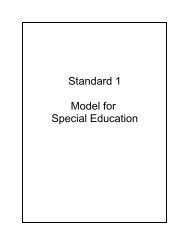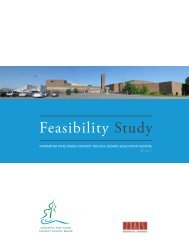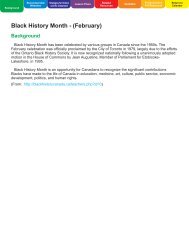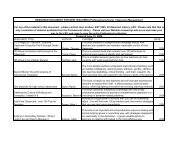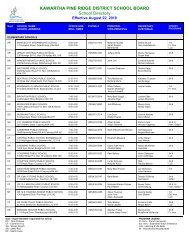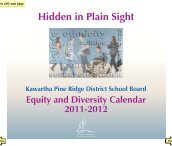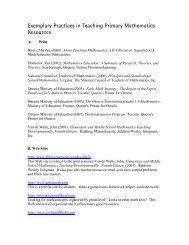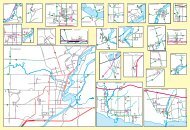THE FUR TRADE GAME - Kawartha Pine Ridge District School Board
THE FUR TRADE GAME - Kawartha Pine Ridge District School Board
THE FUR TRADE GAME - Kawartha Pine Ridge District School Board
You also want an ePaper? Increase the reach of your titles
YUMPU automatically turns print PDFs into web optimized ePapers that Google loves.
<strong>THE</strong><br />
<strong>FUR</strong> <strong>TRADE</strong><br />
<strong>GAME</strong><br />
Teacher Information<br />
Booklet<br />
Program developed by Kathy Beach, <strong>Kawartha</strong> <strong>Pine</strong> <strong>Ridge</strong> <strong>District</strong> <strong>School</strong> <strong>Board</strong>
<strong>Kawartha</strong> <strong>Pine</strong> <strong>Ridge</strong> <strong>District</strong> <strong>School</strong> <strong>Board</strong><br />
<strong>FUR</strong> <strong>TRADE</strong> <strong>GAME</strong><br />
A simulation game whereby the students take on the role of<br />
trading partners working for the North West Company. At the<br />
conclusion of the game, the students will be able to identify some<br />
of the consequences of the Aborginal and European interaction<br />
resulting from the North American Exploration.<br />
<strong>FUR</strong> <strong>TRADE</strong> <strong>GAME</strong><br />
Instructions:<br />
This activity will increase the student’s awareness and understanding of the difficult life of a fur trader<br />
in Canada in the late 1700's.<br />
The students take on the role of a fur trader. Their objective is to become successful at trading and<br />
having the most furs at the end of the game.<br />
Success in the game requires the students to have good navigation and decision-making skills and to<br />
be able to plan out strategies.<br />
Naturalist’s Role:<br />
The role of the naturalist at the Outdoor Education Centre is to facilitate the game. It is important for<br />
the teacher to prepare the students for this game in order to have a successful day.<br />
Teacher’s Role:<br />
Students should be aware of the following concepts and how they are significant to the fur trade:<br />
Beavermeade, beaver hat, voyagers, barter, aboriginal encampment, trading company (e.g.,<br />
Northwest Company, Hudson Bay Company)<br />
Before the class arrives, the “Progress Reports” should be filled out with the names of the partner<br />
pairs. This will be used to “sign in” at the aboriginal trading post and the company store once an hour<br />
as the game proceeds. If a group fails to sign in, the naturalist will go and find them and give<br />
whatever assistance is necessary. The partners should be teacher assigned, rather than “peer
chosen” (boy/girl tends to work well). Teamwork is an important skill developed in this game.<br />
Game Setup:<br />
1. Students form partnerships (assigned). Each student is assigned the role of a specific fur<br />
trader working for the Northwest Company in the late 1700's.<br />
2. Partners will be outfitted with a map, pencils and a package which includes a question sheet<br />
and fur values.<br />
3. Partners, using their maps, must navigate themselves throughout the game area in search for<br />
the aboriginal encampments. This simulates the search for the aboriginal encampments<br />
where the fur traders would go for available furs.<br />
4. Aboriginal encampments are represented by a marker outdoors. The marker will have the<br />
encampment number on it as well as the answer to the corresponding question located on the<br />
Aboriginal Encampment Question Sheet. There is a space on the sheet for the students to fill<br />
in the correct answer. The Aboriginal Encampment Question Sheet can be quickly referenced<br />
on the back of the Record of Trade Sheet.<br />
5. The encampments must be visited to obtain the correct answers to the questions.<br />
6. The encampments may be visited in any order.<br />
7. The more encampments the partners visit, the greater the chances of higher fur values<br />
obtained. The farthest encampments specialize in the highest value furs.<br />
8. When the students have visited a minimum of four "aboriginal encampments" they may come<br />
to the “Company Store” to purchase , on credit, trade items. They can then go to the main<br />
"aboriginal encampment" (the building) to begin trading.<br />
9. To begin trading with the aboriginal (an adult role playing) the students must present the<br />
correct answer to the question on the Aboriginal Encampment Question Sheet that<br />
corresponds with the encampment number that they have visited. For example: If the<br />
students have visited encampment number one they will find the answer to question number<br />
one on the marker.<br />
10. The "aboriginal" may offer a number of furs to the partners if they have the correct answer.<br />
The students must make their own decisions regarding the value of trade items they will offer<br />
the "aboriginal" for these furs. (The Beavermeade value for each trade item is located on the<br />
grey trading cards or can be referenced on the yellow Beavermeade Trading Values Sheet).<br />
11. The partners should note that the quantity of furs at each aboriginal encampment decreases<br />
with the amount of students that visit. This simulates the depletion of furs when an area is<br />
over hunted. There is a possibility that there may not be any fur available at some<br />
encampments as they could run completely out.<br />
12. Once the partners have completed trading for furs it is strongly suggested that they take a few<br />
minutes to convert their fur values into Beavermeade before they go to the Trading Post<br />
(Company Store).
13. Once at the Trading Post (Company Store) the students may “cash in” their furs to get a credit<br />
for the Furs that they have obtained. These transactions are recorded on the Record Sheet<br />
of Trade.<br />
14. Students must know what they would like to purchase at the Company Store before they<br />
speak to the storekeeper (an adult role-playing).<br />
15. The students find out about their initial outfitting supplies at the beginning of the game. These<br />
supplies will be debited to their account. They are expected to pay for these supplies with furs<br />
that may be credited to their account later in the game.<br />
16. Students may trade among themselves.<br />
17. The Trading Post (Company Store) could possibly run out of supplies.<br />
18. If there are enough adults supervisors, an adult (teacher or naturalist preferably) will be<br />
Lord/Lady LUCK and travel the trails, giving students LUCK CARDS to read and record. This<br />
adult can also help lost/confused students.<br />
19. At the signal of a whistle/air horn the students will return directly to the building. They will be<br />
given some time to finish up their trading and then the game will be ended.<br />
20. The winner of the game will be determined by having the largest profit. Profit is determined by<br />
the students subtracting their total debits from their total credits.<br />
21. Under no circumstances shall any student leave the predetermined boundary. If the<br />
students or teachers have any questions or concerns regarding the boundaries, they should<br />
ask the naturalist.
Beavermeade Values for Supplies and Furs<br />
Supplies Available<br />
Axe Heads (5)<br />
Beaver Hat<br />
Blankets (2)<br />
Breeches<br />
Brandy (1 Gallon)<br />
Canoe Awls<br />
Coat<br />
Cloth (10 yards)<br />
Crooked Knife (5)<br />
Dried Peas<br />
Files<br />
Firesteels<br />
Fish Hooks (5)<br />
Flints (10)<br />
Flour (10lbs)<br />
Frying Pan<br />
Fur Scraper<br />
Glass Beads (10 lbs)<br />
Gun Flints (5)<br />
Gun Powder (3lbs)<br />
Gun Powder Horn<br />
Gun Shot (15 lbs)<br />
Hunting Knives (5)<br />
Ice Chisel<br />
Kettle<br />
Mirrors (2)<br />
Musket<br />
Rope (100ft)<br />
Salt (5lbs)<br />
Salt Pork (50lbs)<br />
Sewing Needles (12)<br />
Snare Wire (25 yard)<br />
Spear Heads (10)<br />
Sugar (10 lbs)<br />
Tobacco (2 lbs)<br />
Woolen Cloth (5 yards)<br />
Beavermeade<br />
Value<br />
10B<br />
5B<br />
10B<br />
2B<br />
10B<br />
1B<br />
5B<br />
10B<br />
1B<br />
10B<br />
5B<br />
1B<br />
1B<br />
1B<br />
2B<br />
2B<br />
1B<br />
1B<br />
1B<br />
1B<br />
1B<br />
5B<br />
1B<br />
1B<br />
5B<br />
1B<br />
12B<br />
10B<br />
2B<br />
10B<br />
1B<br />
5B<br />
5B<br />
10B<br />
2B<br />
10B<br />
Furs<br />
Prime Beaver<br />
Beavermeade<br />
Value<br />
1B<br />
Common Beaver 1/2B<br />
Black Bear<br />
Black Bear Cub<br />
Bobcat<br />
Brown Bear<br />
Brown Bear Cub<br />
Coyote<br />
2B<br />
1B<br />
1B<br />
2B<br />
1B<br />
1B<br />
Deer 1/2B<br />
Fisher<br />
Lynx<br />
1B<br />
1B<br />
Marten 1/4B<br />
Mink 1/2B<br />
Moose<br />
Mountain Lion (Cougar)<br />
2B<br />
1B<br />
Muskrat 1/4B<br />
Otter<br />
1B<br />
Rabbit 1/4B<br />
Red Fox 1/2B<br />
Swan Skin<br />
Wolf<br />
Wolverine<br />
1B<br />
1B<br />
2B
Fur Values for Trade (Practice Worksheet)<br />
Fur Value # of Pelts Value # of Pelts Value # of Pelts Value # of Pelts Value<br />
1 Prime Beaver = 1B __ x 1B __ x 1B __ x 1B __ x 1B<br />
1 Comm. Beaver = ½ B __ x ½ B __ x ½ B __ x ½ B __ x ½ B<br />
1 Black Bear = 2B __ x 2B __ x 2B __ x 2B __ x 2B<br />
1 Black Bear Cub = 1B __ x 1B __ x 1B __ x 1B __ x 1B<br />
1 Bobcat = 1B __ x 1B __ x 1B __ x 1B __ x 1B<br />
1 Brown Bear = 2B __ x 2B __ x 2B __ x 2B __ x 2B<br />
1 Brown Bear Cub = 1B __ x 1B __ x 1B __ x 1B __ x 1B<br />
1 Coyote = 1B __ x ½ B __ x ½ B __ x ½ B __ x ½ B<br />
1 Deer = ½ B __ x ½ B __ x ½ B __ x ½ B __ x ½ B<br />
1 Fisher = 1B __ x 1B __ x 1B __ x 1B __ x 1B<br />
1 Lynx = 1B __ x 1B __ x 1B __ x 1B __ x 1B<br />
1 Marten = 1/4 B __ x 1/4 B _ _ x 1/4 B _ _ x 1/4 B __ x 1/4 B<br />
1 Mink = ½ B __ x ½ B __ x ½ B __ x ½ B __ x ½ B<br />
1 Moose = 2B __ x 2B __ x 2B __ x 2B __ x 2B<br />
1 Mountain Lion = 2B __ x 2B __ x 2B __ x 2B __ x 2B<br />
1 Muskrat = 1/4 B __ x 1/4 B _ _ x 1/4 B _ _ x 1/4 B __ x 1/4 B<br />
1 Otter = 1B __ x 1B __ x 1B __ x 1B __ x 1B<br />
1 Rabbit = 1/4 B __ x 1/4 B _ _ x 1/4 B _ _ x 1/4 B __ x 1/4 B<br />
1 Red Fox = ½ B __ x ½ B __ x ½ B __ x ½ B __ x ½ B<br />
1 Swan Skin = 1B __ x 1B __ x 1B __ x 1B __ x 1B<br />
1 Wolf = 1B __ x 1B __ x 1B __ x 1B __ x 1B<br />
1 Wolverine = 2B __ x 2B __ x 2B __ x 2B __ x 2B



